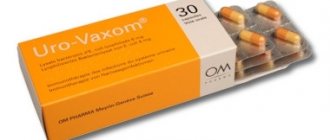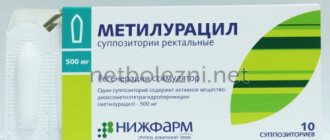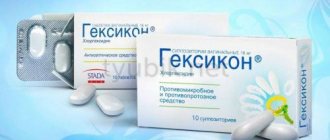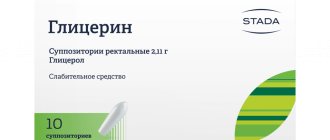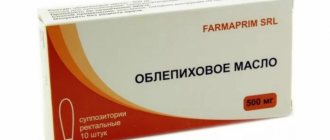METHYLURACIL (suppositories)
Experienced gynecologists and proctologists recommend it as a quick remedy.
The candles are excellent, the effect has been tested many times. The active ingredient in suppositories is methyluracil. Suppositories with this active ingredient are produced by many pharmaceutical companies. But personally, I like the products of the Nizhpharm company. I myself try to buy drugs from this company when necessary, and I also advise my friends, if they have a choice, to buy suppositories from the Nizhpharm company. This pharmaceutical company is located in Nizhny Novgorod.
Here is such a green box, the design is recognizable, standard for the Nizhpharm company. On one side of the box is the name of the medicine, its main purpose, and the name of the manufacturing company.
There is minimal information on the box. Here is the manufacturer information. There is an address and telephone number. By the way, the company has a website.
Here is information about the main active ingredient and excipient of suppositories. The main active ingredient is only one - methyluracil. I won’t describe the properties in detail. In short, methyluracil has anti-inflammatory, analgesic and regenerating properties. This is exactly what is needed for hemorrhoids and gynecological inflammations. The standard excipient is solid fat. The box says that the drug is available with a prescription. Fortunately, they are still sold without a prescription. I hope this continues. The pharmacist warns that these suppositories can be stored at room temperature; it is not necessary to put them in the refrigerator.
The drug has a long shelf life. There are ten candles in a package.
The box contains detailed instructions. It is a little strange that the instructions do not say about the use of suppositories in gynecology, although gynecologists prescribe these suppositories for inflammation of the appendages quite often. I even know that these suppositories are prescribed by therapists and gastroenterologists for the treatment of various gastrointestinal problems. So candles are to some extent universal. And they even have a general strengthening effect. Although probably no one will use them in this capacity. Suppositories are usually remembered when the problem is clearly noticeable. Properties and method of use are indicated in the instructions. There are also contraindications.
The box contains two contour cells of five candles each. This is what one candle looks like in the package (pictured below). Without packaging and suppository, standard torpedo-shaped. The candle is white, does not immediately melt in your hands, is quite convenient and easy to use. The candles have no smell, I don’t feel it. The application is standard, understandable to everyone. If you have questions about the method of use or duration of treatment, then of course it is better to discuss them with your doctor. I have always heard recommendations to use two packs of these suppositories per course and use them for exacerbation of hemorrhoids twice a day, morning and evening.
I have not heard from anyone that candles burn or cause any other discomfort when used. Although, like any medicine, there may be individual intolerance. And if you have never used this drug, then it is worth buying one box to try. Moreover, these candles do not stain clothes and do not leak, so you don’t have to worry about laying anything down. But they have a slight laxative effect, this must be taken into account.
Methyluracil suppositories are effective. Helps with exacerbation of hemorrhoids. It is traditionally believed that after using a candle it is better to lie down for about thirty minutes and it is better to put any candles at night. There is also such a recommendation for Methyluracil in the instructions. From experience I will say that you can use it in the morning and lie down if you don’t have time, it’s not necessary. The spark plugs don't leak.
Suppositories with Methyluracil work well in combination with candles with sea buckthorn oil. The layout of these candles is different. You can use two suppositories at once with an interval of half an hour, you can use Methyluracil in the morning, and Sea Buckthorn oil in the evening. Here the doctor will recommend it depending on the situation. There are still very good Sea Buckthorn oil candles from the Nizhpharm company. If they are not on sale, then you can, in principle, buy any candles with sea buckthorn oil as the main active element. You can take Olestezin from the Altaivitamin company, but Olestezin is good on its own; in addition to sea buckthorn oil, it also contains an analgesic and anti-inflammatory component. And in combination with Methyluracil, it is better to look for candles only with sea buckthorn oil. For example, simple and inexpensive candles “Sea Buckthorn Oil” from “.
I consider Methyluracil suppositories from the Nizhpharm company to be a good, effective medicine. Of course, before use, I advise you to discuss the feasibility and regimen of use with a doctor you trust. I'm just sharing my impressions, the information is always useful. Maybe the advice will be useful to someone or you, in turn, will tell someone about this simple and accessible remedy. If the doctor prescribes suppositories with Methyluracil, then the drug from Nizhpharm is good. These suppositories help better than many expensive drugs, and they cost differently in different pharmacies, from sixty (at the Maksavit pharmacy, for example, these suppositories are the cheapest) to one hundred rubles, but the price is in any case very affordable.
Of course, I always wish everyone that information about medications remains at the level of only theoretical knowledge. Be healthy, thank you everyone for your attention to the review.
Methyluracil
Methyluracil is a stimulator of immunity and tissue regeneration. It is produced in various dosage forms (tablets, ointments, suppositories) by a number of domestic enterprises: Biokhimik, Nizhpharm, Obnovlenye, Rosbio, Valenta Pharmaceuticals, Altaivitamins, Dalkhimfarm, Sintez, etc. Stimulates cell growth and reproduction, acting as a repair agent and accelerating the restoration of damaged tissues. Promotes rapid healing of wounds, erosive and ulcerative lesions, burns. Increases the body's resistance to invasion by bacterial and viral agents. Normalizes protein metabolism, activates cell regeneration in the area of damage, accelerates tissue epithelization, strengthens cellular and humoral immunity. Shows anabolic activity. External forms have a photoprotective effect. A distinctive feature of the drug is its ability to stimulate hematopoiesis (to activate the processes of formation of white and red blood cells in the bone marrow). In addition to this, methyluracil exhibits an anti-inflammatory effect, increases the body's tolerance to blood loss and hypoxia, normalizes gastric secretion and the acid-base balance of gastric juice. The tablet form of methyluracil is prescribed for the treatment of mild forms of leukopenia (including those that developed as a result of chemotherapy for malignant tumors, radiotherapy or x-ray therapy), ulcerative necrotic lesions of the pharynx and tonsils, septic tonsillitis, anemia, decreased platelet counts, benzene poisoning, ulcerative erosive lesions of the gastric and duodenal mucosa, slowly healing wounds, burns, bone fractures, hepatitis, etc.
d. The external form (ointment) is used to treat slow-healing wounds, burns, the so-called. “sun allergy” (photodermatitis), trophic ulcers of the lower and upper extremities, bedsores. Local forms (suppositories) are used for inflammation of the mucous membrane of the rectum and sigmoid colon, ulcerative colitis. Methyluracil has a relatively small number of side effects: these are allergic reactions, and for internal forms - vertigo, headaches, heartburn. The drug is contraindicated in cases of hypersensitivity to the active component, leukemia, malignant processes in the bone marrow, excessive wound granulation (for external and local forms). Methyluracial in the form of an ointment combines well with external applications of disinfectants and antibacterial agents. Clinically significant interactions (increased or decreased effects of drugs when used together) have not been established for methyluracil. A number of sources (mainly from the Soviet period) indicated the possibility of using methyluracil tablets to stimulate anabolic processes during sports, but not a single study has been conducted that would confirm the effectiveness of the drug for sports purposes.
Urogenital disorders in postmenopause and hormone replacement therapy
Changes in the demographic structure of society in the second half of the 20th century. led to an increase in the proportion of women in the older age group in the population. The number of women entering menopause increases every year. If 75 years is taken as 100%, then the duration of the prepubertal period is 16%, the reproductive period is 44%, the premenopausal period is 7%, and the postmenopausal period is 33% (H. Haney, 1986). That is, a woman spends more than a third of her life in a state of deficiency of female sex hormones. Menopause, while not being a disease itself, leads to disruption of the endocrine balance in a woman’s body, causing hot flashes, irritability, insomnia, urogenital disorders, and also increasing the risk of developing osteoporosis and cardiovascular diseases. All these data indicate the need to develop a number of medical and social measures to protect the health, maintain productivity and a decent quality of life for peri- and postmenopausal women.
In recent years, the problem of urogenital disorders has become a leader in the symptomatology of menopausal disorders, which is associated with their pronounced negative impact on the quality of life of postmenopausal women. The incidence of age-related urogenital disorders reaches 30%. In the perimenopausal period, urogenital disorders occur in 10% of women, while in the age group of 55-60 years - in 50%. By the age of 75, 2/3 of women already experience urogenital discomfort, and after 75 years it is difficult to meet a woman who has not experienced individual symptoms of urogenital disorders.
Urogenital disorders in menopause are a symptom complex of secondary changes associated with the development of atrophic and dystrophic processes in estrogen-dependent tissues and structures of the lower third of the genitourinary tract, bladder, urethra, vagina, pelvic ligaments and pelvic floor muscles.
A progressive increase in the incidence of urogenital atrophy with age is associated with irreversible age-related metabolic changes that develop against the background of estrogen deficiency. The vagina, urethra, bladder and lower third of the ureters have a single embryonic origin and develop from the urogenital sinus. This explains the presence of receptors for estrogen, progesterone and androgens in the muscles, mucous membrane, choroid plexuses of the vagina, bladder and urethra, as well as in the muscles and ligaments of the pelvis.
The aging processes of the urogenital tract develop in two directions:
- predominant development of atrophic vaginitis;
- predominant development of atrophic cystourethritis with or without symptoms of impaired urinary control.
Atrophic vaginitis occurs as a result of estrogen deficiency and is characterized by a sharp thinning of the vaginal mucosa, cessation of proliferative processes in the vaginal epithelium, a decrease in glycogen production by epithelial cells, a decrease or complete disappearance of lactobacilli, and an increase in vaginal pH (see Table 1).
The main clinical manifestations of atrophic vaginitis are vaginal dryness and itching, recurrent discharge, dyspareunia, and contact bleeding.
Diagnosis of atrophic vaginitis includes:
- The patient complains of dryness and itching in the vagina; recurrent discharge, often regarded as a symptom of recurrent colpitis; contact bleeding.
- objective examination methods: extended colposcopy: thinning of the vaginal mucosa, bleeding, petechial hemorrhages, numerous translucent capillaries are determined; colpocytological study - determination of the karyopyenotic index (KPI), which decreases to 15–20 with the development of atrophic processes in the vagina, or determination of the maturation index (MI). IS is assessed by a shift in the formula: a shift in the formula to the left indicates atrophy of the vaginal epithelium; Determination of vaginal pH - Vaginal pH in untreated postmenopausal women is 5.5–7.0 depending on age and sexual activity. In sexually active women, the pH is slightly lower. The higher the pH, the greater the degree of atrophy of the vaginal epithelium.
Manifestations of atrophic cystourethritis include “sensory” or irritating symptoms:
- cystalgia - frequent, painful urination during the day, accompanied by a burning sensation, pain and cutting in the bladder and urethra;
- pollakiuria - increased urge to urinate (more than four to five episodes per day) with the release of a small amount of urine with each urination;
- nocturia - increased urge to urinate at night (more than one episode of urination per night);
- stress urinary incontinence (during physical activity, coughing, sneezing, laughing, sudden movements, lifting weights);
- urinary incontinence (urine flows out without strain due to imperative urges).
Examination of women with urinary disorders:
- patient complaints;
- Valsalva test - a woman with a full bladder in a position on a gynecological chair is asked to forcefully push. The test is considered positive if drops of urine appear in the area of the external urethral opening;
- cough test - a woman with a full bladder in a position on a gynecological chair is asked to cough. The test is considered positive if urine leaks when coughing;
- pad test - the weight of the pad is determined after an hour of exercise. If the weight of the pad increases by more than 1 g, then urinary incontinence occurs;
- urine culture for infection and sensitivity to antibiotics;
- urodynamic examination (carried out by urologists) - uroflowmetry, cystometry, urethral profilometry, electromyography.
The identification of the symptoms of atrophic vaginitis and cystourethritis is conditional, since in most cases they are combined. Various combinations of symptoms of atrophic vaginitis and cystourethritis made it possible to distinguish three degrees of severity of urogenital disorders (V. E. Balan, 1997).
Mild urogenital disorders (16% of women) include a combination of symptoms of atrophic vaginitis and “sensory symptoms” of atrophic cystourethritis without disturbance of urination.
Moderate urogenital disorders (80% of women) include a combination of symptoms of atrophic vaginitis, cystourethritis and true stress urinary incontinence.
Severe urogenital disorders (4% of women) include a combination of symptoms of atrophic vaginitis, cystourethritis, true stress urinary incontinence and urinary incontinence.
So, it has been established that estrogen deficiency is the cause of the development of urogenital disorders in women during menopause. The problem of treating urogenital disorders is controversial. The emphasis is on what type of hormone replacement therapy (HRT) is considered optimal. HRT for urogenital disorders can be carried out with drugs that have both systemic and local effects. Systemic HRT includes all drugs containing estradiol, estradiol valerate and conjugated estrogens.
Local HRT includes drugs containing estriol. The choice of the type of HRT for the treatment of urogenital disorders is individual and depends on the patient’s age, duration of postmenopause, leading complaints, the need to treat menopausal syndrome or prevent late metabolic disorders.
The prescription of systemic HRT must comply with generally accepted rules, taking into account absolute and relative contraindications. When prescribing HRT to patients with urogenital disorders, the goal is to restore the normal state of local hormone-dependent structures of the lower parts of the genitourinary system and stimulate biological tissue defense mechanisms.
When deciding on the type of drug for HRT, it is extremely important to determine:
- menopause phase - perimenopause or postmenopause;
- whether we are talking about an intact uterus or the uterus is absent (if absent, then why was the hysterectomy performed).
For an intact uterus, combination therapy with drugs containing estrogens and gestagens is used:
- in perimenopause - two-phase drugs (Climen, Klimonorm, Divina, Cycloproginova, Femoston, etc.) or three-phase drugs (Trisequence);
- in postmenopause - combined monophasic drugs in a continuous mode (Cliogest, Gynodian-Depot, Livial, Climodien, Pausogest, Femoston, etc.).
In women after hysterectomy, systemic exposure is provided by monotherapy with natural estrogens in a cyclic or continuous mode (estrophem, progynova, climara, divigel, estraderm).
A priority role in the choice of HRT for urogenital tract disorders caused by decreased gonadal function belongs to estriol-containing drugs that have selective activity in relation to the genitourinary system. The specificity of the action of estriol is determined by the characteristics of its metabolism and affinity with the corresponding receptor systems. The local effect of steroid hormones is realized through their passive diffusion into the cells of the body. Retaining only in the cells of sensitive tissues, they form complexes with cytosolic receptors, followed by translocation into the cell nucleus. In this way, the action is realized at the level of the genetic structures of the cell. This determines the specificity of the effect characteristic of a given tissue.
The response of tissues to the effects of estrogens is determined by the concentration of receptors, their structure and properties of estrogens. Estriol is the final metabolite in estrogen metabolism. It is excreted from the body in conjugated form in the urine and only in small quantities is excreted in feces, mainly in unconjugated form.
When estriol is administered orally, its maximum concentration in the blood plasma is reached after 1-2 hours. Estriol that enters the blood plasma does not bind to sex steroid-binding globulin and is eliminated quite quickly. Estriol is the least active estrogen with a short-term effect.
It has been established that tissues sensitive to estriol are widely represented in the lower parts of the urogenital tract. Estriol therapy promotes the development and restoration of the vaginal epithelium, and also leads to the restoration of the main elements of connective tissue - collagen and elastin. At the same time, the main thing in prescribing estriol-containing drugs is minimal systemic effect. It is known that to stimulate the development of the endometrium, the connection of its receptors with estrogen must be long-lasting, at least 8-10 hours. Estriol binds to structures sensitive to it for no more than 2-4 hours. Such a short-term effect is not enough for the proliferative reaction of the endometrium, but sufficient to effectively influence the structures of the lower parts of the urogenital tract. Thus, with a single administration, estriol binds to the nuclear receptor for a short time and does not cause endometrial proliferation, therefore, when administered, the addition of progestogens is not required.
For urogenital disorders, preference is traditionally given to local administration of estrogens and specifically estriol (Ovestin) in ointments and suppositories (see Table 2).
In any form, estriol-containing preparations are taken once a day. The combination of systemic and local forms of the drug is not recommended.
The choice of therapy also depends on the severity of urogenital disorders.
For mild urogenital disorders, estriol preparations (suppositories, cream) are used daily or three times a week, depending on the severity of clinical symptoms. When the phenomena of atrophic vaginitis or atrophic cystourethritis are combined with menopausal syndrome, drugs for systemic HRT are prescribed.
For moderate severity of urogenital disorders, combined therapy (systemic and local) is carried out for at least six months to normalize urodynamic parameters.
In case of severe urogenital disorders in the case of existing indications for systemic HRT, combination therapy with drugs for systemic HRT is carried out in combination with local administration of estriol drugs and one of the additive drugs that have a selective effect on cholinergic (parasympathetic) and adrenergic (sympathetic) or muscarinic receptors, located in the muscular wall of the bladder and various structures of the urogenital tract: the smooth muscle of the urethra and the pelvic floor muscles involved in creating urethral support. Combination therapy must be carried out for six months or more, after which the question of the type of therapy is decided individually for each patient (see Table 3).
| Table 3. Treatment regimen for urogenital disorders. |
This system of differentiated HRT can improve the quality of life of patients with urogenital disorders by 60-70%.
Thus, the presented data allow us to talk about HRT as the main treatment for urogenital disorders in postmenopause.
Due to the progressive nature of urogenital disorders, preference is given to the prophylactic use of HRT and its long-term use. HRT for urogenital disorders should be prescribed for a long time, almost for life, and in this situation it is local therapy with estriol that comes to the rescue.
Today, modern medicine has a fairly wide selection of good drugs for HRT and experience in their use, indicating that the benefits of prescribing HRT significantly outweigh the risk of side effects. All this gives reason to recommend the widespread use of HRT for the prevention and treatment of urogenital disorders in peri- and postmenopause in order to improve the quality of life and preserve the working capacity of women entering this “autumn” period.
A. L. Tikhomirov, Doctor of Medical Sciences, Professor Ch. G. Oleinik, Candidate of Medical Sciences MGMSU, Moscow
Literature:
- Balan V. E.//Gynecology. - 2000. - No. 5; 2. - pp. 140-142.
- Balan V. E., Ankirskaya A. S., Yesesidze Z. T., Muravyova V. V. //Consilium medicum. 2001; No. 7; 3. - pp. 326-331.
- Kulakov V.I., Smetnik V.P. //Guide to menopause. - M., 2001. - 685 p.
- Romanyugo N.N.//Practical gynecology. - 1999. - No. 1; 1. - pp. 28-29.
- Alsina CJ //Maturitas. 1996; 33; 51-57.
- Crook D., Godsland IF //Br. J. Obstet. Gynaecol. 1997; 104; 298-304.
- Heikkinen JE, Vaheri RT //Am. J. Obstet. Gynecol. 2000; No. 3; Vol. 182; 560-567.
- Pickar JH //Am. J. Obstet. Gynecol. 1998; 178; 1087-1099.
- Samsioe G. //Menopause Review. 1998; 3 (1); 9-17.
